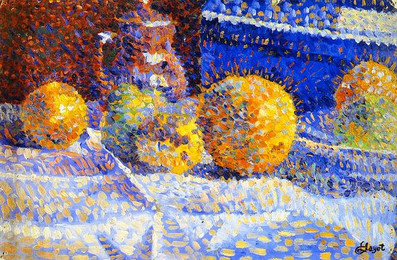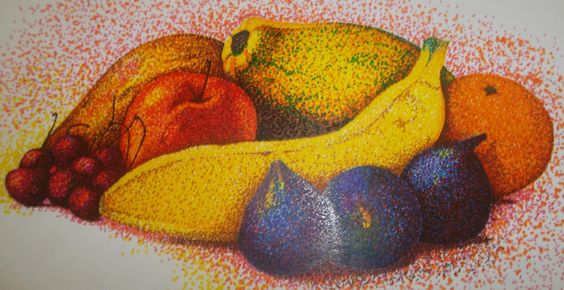LESSON PLANS WINTER TERM 2022 (2nd half) Lesson 3. Pointillism and pastels!
- Clare Shepherd

- Nov 4, 2022
- 2 min read
In this lesson I'm asking my students to think about the mingling of colours with dots and dashes in a technique known as pointillism. I'd like them to work from a bowl of fruit and to create the lusciousness of colour and tone through pointillism. Above are some examples of exactly that.
Winter term, 2nd half 2022. Lesson 3. Pointillism! Using soft pastels OR oil pastels you’re going to construct a dotty picture. Fruit will be your main subject, either from a still-life in front of you or from a good picture of a fruity still-life. You can add cloth, bowl etc., your choice.
· Have a quick look at some pictures on my laptop. See how the dots of colour mingle and build up to create solid looking forms.
· Set your still-life up in front of you (or have the picture you’re working from at easy access).
· You can work on coloured pastel paper or white paper. Coloured paper is a good option because it gives you access to making light dots as well as dark dots.
· You can dive in with the dotting immediately OR using your pastels on the side you can very lightly block your main shapes. Alternatively, you can very lightly draw some indicative lines if that helps.
· Think about the fruits you’re looking at. If you’re looking at an orange it wold be perfectly feasible to use the following colours: Orange, yellow, yellow ochre, green, blue, white and brown!
· Look for the different tones across a piece of fruit and begin to build up, with dots and dashes, the colours and tones you’re seeing.
· Look at the areas between the fruits and ask yourself how, along the edges of your fruit, they relate to their background? Are they darker or lighter than their background (it’ll never be what you expect).
· This is a very negotiable process, you can put light on dark and dark on light dots. Build up all areas across your page.
Next lesson: Using soft pastels for a softer, smudgier still-life. Bring fruit (or fruity image) and we’ll use the pastels in a very different way. Coloured paper is really good but white paper is fine too if you prefer. Bring a soft paintbrush for smudging.
























Comments